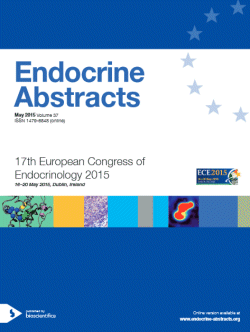Searchable abstracts of presentations at key conferences in endocrinology
Symposia
Endocrine consequences of childhood cancer treatment
ea0037s20.1 | Endocrine consequences of childhood cancer treatment | ECE2015
Reproductive function in cancer survivors
With increasing numbers of survivors from cancer at a young age the issue of fertility preservation has assumed greater importance. Female fertility preservation provides significantly different challenges to that for the male. Embryo freezing is now an accepted and well-established procedure in many centres, but is not available for children who do not have a partner. Cryopreservation using vitrification of mature oocytes has become increasingly successful, but requires the p...
ea0037s20.2 | Endocrine consequences of childhood cancer treatment | ECE2015
Hypopituitarism in cancer survivors
Survival rates of childhood cancer have improved markedly and today more than 80% of those diagnosed with a pediatric malignancy will become 5-year survivors. Nevertheless, survivors exposed to cranial radiotherapy (CRT) are at particularly high risk for long-term morbidity, such as endocrine insufficiencies, metabolic complications and cardiovascular morbidity. Deficiencies of one or more anterior pituitary hormones have been described following therapeutic CRT for primary br...
ea0037s20.3 | Endocrine consequences of childhood cancer treatment | ECE2015
Late effects of cancer treatment on cardiovascular risk
In the last 50 years survival after childhood cancer has dramatically improved. However, childhood cancer survivors (CCS) are at risk for a considerable array of late effects arising from previous anti-cancer therapies. The excess mortality (compared with the general population) in CCS is mostly due to second neoplasms and cardiovascular diseases. Indeed, the cardiovascular system has been recognized as a highly sensitive target for damage by anti-cancer therapies. Early in th...
ea0037s20.5 | Endocrine consequences of childhood cancer treatment | ECE2015
Secondary cancers in childhood cancer survivors
Due to marked advances in curative therapy for childhood cancer mainly the introduction of modern chemotherapy in the 1960s the 5-year survival rate after childhood cancer has substantially improved over the last few decades from less than 30% in the 1960s to currently over 80%. As a result of these improved survival rates, a large and ever growing number of childhood cancer survivors have reached adulthood. A major concern following treatment of childhood cancer...




